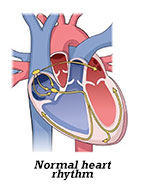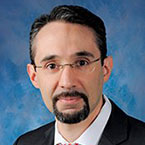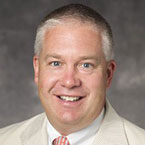By: Orhan Kilinc, MD, FAAP, and Christopher S. Snyder, MD, FAAP
The heart is one of the most active muscles in the body, beating some 50 million times in a child's first year of life. It's normal for a child's heartbeat to speed up or slows down as they play, sleep and grow.
But what if your child's heartbeat seems faster or slower than it should be, or has an unusual pattern? In this article, the American Academy of Pediatrics describes normal heart rate fluctuations in kids, and what might be cause for concern.
Reasons for irregular heartbeats
 Ordinarily, special "pacemaker" cells in the heart send electrical impulses from upper to lower chambers (atria and ventricles), which take turns squeezing and relaxing to pump blood throughout the body. There are many factors that can influence this rhythm. These include
physical activity, stress or excitement, for example. Fever, dehydration, and medical conditions like
anemia can also play a role. So can certain medications or consuming
energy drinks and other caffeine-containing beverages. In addition, some children are born with
congenital conditions that affect the heart's muscles or electrical pathways and the way it pumps.
Ordinarily, special "pacemaker" cells in the heart send electrical impulses from upper to lower chambers (atria and ventricles), which take turns squeezing and relaxing to pump blood throughout the body. There are many factors that can influence this rhythm. These include
physical activity, stress or excitement, for example. Fever, dehydration, and medical conditions like
anemia can also play a role. So can certain medications or consuming
energy drinks and other caffeine-containing beverages. In addition, some children are born with
congenital conditions that affect the heart's muscles or electrical pathways and the way it pumps.
Irregular heartbeats that are usually normal
Irregular heartbeats, also called arrhythmias, are a common reason for referral to a pediatric cardiologist. Most often, these irregularities turn out to be perfectly normal. Examples of these common but usually harmless arrhythmias include:
Respiratory sinus arrhythmia - the most common irregular heart rate in children. It's caused by the normal change in how fast blood returns to the heart when they breath in or out. The heart beats faster when they inhale, and slower when they exhale. The name "arrhythmia" is actually misleading, since this variation in heartbeats occurs in all healthy children in varying degrees.
Premature or "skipped" heart beats - seen in up to 75% of pediatric patients. These irregular beats may start in either the top chambers (premature atrial contractions) or the bottom chambers (premature ventricular contractions) of the heart. Patients feel like their heart "skipped" a beat due to a pause in the rhythm followed by a more forceful beat.
Irregular heart rhythms that may need evaluation & treatment
There are other types of irregular heartbeats that may need be treated or monitored. These include:
Abnormally fast heartbeats
Supraventricular tachycardia (SVT) is the most common abnormal pediatric heart rhythm, affecting as many as 1 in 250 children. It happens when electrical signals in the upper chambers of the heart misfire and cause a sudden burst of abnormally fast, "racing" heartbeats that last for seconds, minutes or longer. About half of children with SVT, sometimes called atrial tachycardia, are diagnosed as infants. Episodes of SVT usually go away by a child's first birthday, although it can return.
There are different types and causes of SVT, including:
-
Wolff-Parkinson-White syndrome affects children born with an extra electrical pathway in the heart. That extra pathway may allow impulses to move in a different direction and faster than usual.
- Atrial flutter & atrial fibrillation happens when electrical signals from the upper chamber of the heart are faster than those in the lower chamber, causing the heart to flutter rather than fully squeezing for a regular beat. Atrial fibrillation is another type of abnormally fast, quivering heart rhythm that is similar to atrial flutter, but the abnormally fast beats are less regular. These conditions make it difficult for the heart to pump blood effectively and increases the risk of problems like blood clots. Both are much less common than other types of SVT. Research suggests they may be inherited genetically or linked to
congenital heart abnormalities or heart muscle disorders like
cardiomyopathy.
Ventricular tachycardia (VT) is a series of heartbeats starting in the lower chambers of the heart, rather than the upper chambers like normal, that cause an abnormally fast rhythm. It is rare in children, but early identification can be lifesaving since it can raise the risk of
sudden cardiac arrest. One type of VT is
Long QT syndrome, an inherited condition that affects an estimated 1 in 2,500 people. It causes the lower chambers of the heart to take too long to contract and release, causing a fast and chaotic heart rhythm.
Abnormally slow heartbeat
Bradycardia – when the heart rate is below the normal low range for a child's age. In children, two of the most common types are:
-
Sinus bradycardia is seen more often in premature infants. Possible causes include medications the baby was exposed to before birth, breathing problems or a drop in body temperature called
hypothermia.
-
Heart block is when electrical signals are prevented from passing from the upper to lower chambers of the heart. The condition often is caused by structural problems in the heart that affect the atrioventricular (AV) node, a cluster of specialized heart cells in the right atrium that act as a natural "pacemaker."
Signs & symptoms of an abnormal heart rhythm in children
Infants with abnormal heart rhythms may seem extra irritable or fussy, have feeding difficulties, appear pale, and lack energy. Older children tend to have more specific symptoms such as feeling a fluttering or pounding known as heart palpitations,
lightheadedness or fainting, chest pain or discomfort, and difficulty breathing.
How are abnormal heart rhythms diagnosed?
If your child's doctor suspects a heart rhythm problem after the physical exam, he or she will recommend
cardiac testing, which may include:
- Electrocardiogram (ECG or EKG). This fast and simple test usually is the first one recommended to check for abnormal rhythm. It is usually able to confirm a diagnosis, but sometimes additional testing may be needed.
- Wearable heart monitors. If a heart rhythm problem seems to come and go, or happens only in certain settings, a wearable heart monitor may help with diagnosis. Devices such as a Holter monitor let an older child press button when they feel symptoms over the course of a day or more. The doctor can then look at what the monitor showed was happening in the heart at that moment.
- Stress test. If the abnormal heart rhythm tends to happen mostly during exercise, the doctor may order an exercise stress test. Your child rides a stationary bike or runs on a treadmill while the doctor monitors the heart rhythm.
- Tilt-table test. For children with abnormal rhythms linked to fainting, a
tilt test can show how heart rate and blood pressure changes when a child goes from lying down to standing up.
- Imaging tests. Although uncommon, certain heart rhythm conditions may signal problems with the heart's structure. In these cases, imaging tests such as an echocardiogram (ultrasound of the heart) may be needed.
Your pediatrician will likely refer you to a
pediatric cardiologist for follow up. A pediatric electrophysiologist, who specializes in testing for heart rhythm disorders, may also be part of your child's care team.
Treatment for arrythmia
Although heart rhythm disorders can be worrisome, treatments and cures are available. Many heart rhythm problems can be controlled with medications. Implantable devices such as artificial pacemakers can also help keep heart rhythms regular. Other options include corrective surgery and other procedures such as
radiofrequency ablation, which uses radio waves to heat up certain heart cells in the heart to prevent them from letting electrical currents through.
Additional Information :
About Dr. Kilinc
 Orhan Kilinc, MD, FAAP, a pediatric electrophysiologist at Joe DiMaggio Children's Hospital, is a member of the American Academy of Pediatrics (AAP) Section on Cardiology and Cardiac Surgery, is, and the AAP Florida Chapter.
Orhan Kilinc, MD, FAAP, a pediatric electrophysiologist at Joe DiMaggio Children's Hospital, is a member of the American Academy of Pediatrics (AAP) Section on Cardiology and Cardiac Surgery, is, and the AAP Florida Chapter.
About Dr. Snyder

Christopher S. Snyder, MD, FAAP, Chair of the AAP Section on Cardiology and Cardiac Surgery, is Director of Pediatric Cardiology at Rainbow Babies and Children's Hospital, Case Western Reserve University School of Medicine. He is also a member of the Ohio AAP chapter.
Image source: U.S. National Library of Medicine